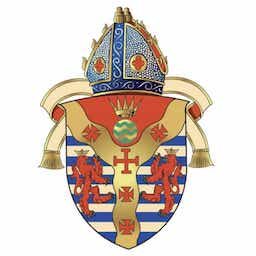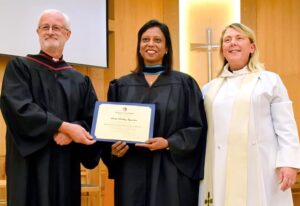The Diocesan Clergy Retreat and Pilgrimage in the Holy Land concluded on Thursday (4 September), with a moving message from Bishop Sean describing the transformational experience of “following in the historic footsteps of Jesus—attentive to where God may be at work here and now”.
“We are leaving here changed,” said Bishop Sean.
Bishop Sean and his Diocesan clergy colleagues the Reverend Franklin Isaac and the Reverend Deborah Moorgas were hosted by St George’s College Jerusalem—an agency of the Diocese of Jerusalem providing the Anglican Communion and beyond opportunities for pilgrimage, education, hospitality and reconciliation. The programme was organised College Dean the Very Reverend Richard Sewell and course director the Reverend Dr Rodney Aist, with the support of a dedicated facilities staff, each one of whom conveyed the most heartfelt hospitality.
Bishop Sean expressed his deep gratitude to the College for their offer to host Diocesan clergy for this time of pilgrimage and prayer; a pilgrimage that was, he said, “very much a pilgrimage with you online”—reference to the wider Diocesan family with whom he, Reverend Franklin and Reverend Deborah shared so many spiritually rich and moving reflections as they journeyed through the Holy Land (links provided below).
The pilgrimage was also, importantly, said Bishop Sean, “an opportunity to convey in person the sense of solidarity the people of Cyprus and the Gulf feel for our brothers and sisters in the Diocese of Jerusalem”.
Bishop Sean and Diocesan clergy colleagues were the first group to visit the College since 2023, reflecting the wider, severely challenging, economic environment for the people of the Holy Land, whose livelihoods and wellbeing depend on engagement with pilgrims and visitors from around the world.
Scroll down for links to daily posts from the Diocesan Clergy Retreat and Pilgrimage in the Holy Land, held on 31 August-4 September 2025. (Click to view programme.)
31 August
Bishop Sean, Reverend Franklin and Reverend Deborah arrive at St George’s College, Jerusalem, grateful for prayers as they travelled.
“You are all so welcome,” said Dean Richard, “and it is a joy to have you with us for your retreat and pilgrimage.”
At the end of their first day in the Holy Land, Bishop Sean shares a message from the Mount of Olives, where the group celebrated Evening Prayer.
1 September
After Morning Prayer from the Chapel of St George’s Cathedral, Jerusalem, Bishop Sean shares a message from the grounds of St George’s College—prompted by the image of ripe pomegranates growing in the College grounds.
“In Christian religious art,” he writes, “a broken or bursting pomegranate is a metaphor for the suffering and resurrection of Jesus Christ. The many red seeds recall the blood that was shed during Christ’s Passion. The act of breaking open the rough exterior to reveal the abundant, beautiful seeds can represent how suffering and death ultimately lead to eternal life.”
A hybrid in-person and online retreat session is an opportunity for the people of the Diocese to join Bishop Sean and his colleagues for a period of “classroom” reflection and prayer before a day of pilgrimage, to Jerusalem and Bethlehem.
“This symbolism depicts self-sacrifice, compassion, and the nurturing of offspring,” said Bishop Sean, “rooted in the medieval legend that a mother pelican wounds her own breast to feed her young with her blood during times of famine.
“We reflect on the famine not far from us, and the sacrificial and desperate love of parents for their suffering children.
“This myth also led to the pelican becoming a powerful symbol for Christ, representing his sacrificial death and the gift of his body and blood in the Eucharist—and so a most appropriate symbol in this traditional site of the Last Supper.”
In Bethlehem, Bishop Sean describes the group walking “from Manger Street along the Separation Barrier and its graffitied messages of deep anger and pain, lament and challenge, of memory and tribute, and even of hope.
“The barrier recalled for us the painful divisions that exist in our world, our diocese, and in our lives—recalling St Paul in Ephesians 2.14: ‘For Christ is our peace; in his flesh he has made both groups into one and has broken down the dividing wall, that is, the hostility between us.’
“May Christ break down every dividing wall in our lives.”
Finding a “hopeful place of ‘breakthrough’”, Bishop Sean, Reverend Deborah and Reverend Franklin share their reflections on the Separation Barrier.
Then, at the Church of the Nativity, white doves, symbols of peace and gentleness.
The silver star on the ground in the grotto beneath the Church marks the traditional place of Jesus’s birth. “Here,” says Bishop Sean, “heaven touched earth, and God became one of us.”
And from the Cloisters of the Church, the stirring sound of Mr Aboud—a Syrian Orthodox Christian—singing the Lord’s Prayer in Jesus’s language of Aramaic.
Bishop Sean shares a Reflection from the Church of the Nativity—and then, “After an extraordinary day of visiting and experiencing both holy and harrowing places, we said Evening Prayer in St George’s Cathedral.
“We continue to pay prayerful attention to where God is and what God wishes to shown us in these places, and in the uncertainty and woundedness of the world around us,” he says.
“We finished the day in the gracious presence of Archbishop Hosam talking about our dioceses and region, and praying together.”
2 September
Bishop Sean, Revd Franklin and Revd Deborah begin their second day of pilgrimage on the banks of the Jordan River, after a moving reaffirmation of their baptismal vows. Watch Bishop Sean’s Pilgrimage Reflection from the Jordan—traditional place of Jesus’s baptism and a border between countries—inviting questions of boundaries and crossing places during our own life journey.
A second Reflection, from St George’s College course director the Reverend Dr Rodney Aist, comes from the shores of the Sea of Galilee. Here, the group attended midday prayers at the Benedictine Monastery of Tabgha—site of the feeding of the 5,000. (Click to hear the monks at prayer.)
A silent lunch at the Monastery is followed by coffee and conversation with the monks. The group then make their way on foot to Mensa Christi, moving on to the Mount of Beatitudes before making their way back to Jerusalem via the Judaean Wilderness.
3 September
On the group’s third day, in Jerusalem, Bishop Sean speaks about the group’s visit to Haram al-Sharif and the Dome of the Rock.
Revd Rodney looks over the Pool of Bethesda, site of the group’s visit the previous day, describing the surroundings as they would have been in the time of Jesus.
4 September
A second hybrid retreat session enables members of the Diocese to join Bishop Sean and his colleagues for a final period of reflection and prayer from St George’s College.
Sitting in the Bishop of Jerusalem’s Peace Garden, Bishop Sean shares deep gratitude to the staff of St George’s College for hosting Diocesan clergy for what has been a profound and life-changing retreat and pilgrimage in the Holy Land for himself, Reverend Franklin Isaac and Reverend Deborah Moorgas, and he gave thanks for the companionship of those who joined them on the journey online.



